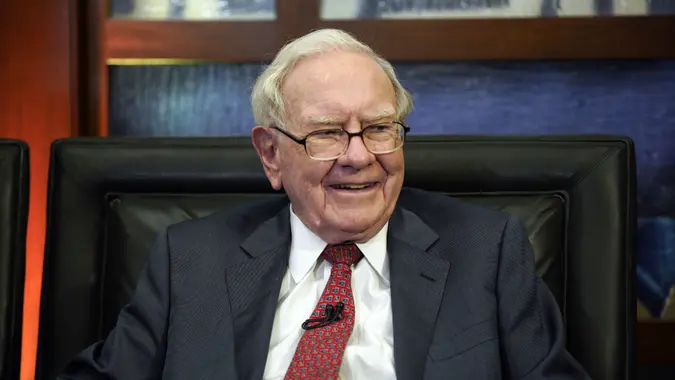How To Protect Your Stock Portfolio From a Stock Market Crash

Commitment to Our Readers
GOBankingRates' editorial team is committed to bringing you unbiased reviews and information. We use data-driven methodologies to evaluate financial products and services - our reviews and ratings are not influenced by advertisers. You can read more about our editorial guidelines and our products and services review methodology.

20 Years
Helping You Live Richer

Reviewed
by Experts

Trusted by
Millions of Readers
Historically, the stock market has always gone up over time, but the trajectory is never a straight line. There are always declines, and that makes investors understandably nervous. And while downturns are inevitable, a market crash can be particularly concerning.
How can you protect your portfolio from a market crash? Here’s what you need to know.
The ‘Go to Cash’ Dilemma
When a crash seems imminent, it can be tempting to move your investments out of the stock market and into cash. But is that the right move? And how do you know when — and how — to get back in? David Capablanca, trading expert, host of “The Friendly Bear” podcast and founder of Friendly Bear University, suggested watching the experts.
“It’s always important to follow the big money and pay attention to major investors like Warren Buffett,” Capablanca said. “Right now, Buffett has built up a significant cash position. His first priority is to protect his capital, and the second is to be in a position to take advantage of a market correction.”
If you go to cash, Capablanca recommended being ready to get back in when the market starts to come back. “Being in cash means being flexible — having liquidity to seize opportunities when they arise,” he said. “Just like in 2020, when the market crashed, those who were ready and had cash available were able to capitalize on the opportunity.”
Capablanca also advised being thoughtful about your purchases when you get back into the market. “When big drops happen in the market, you don’t want to just jump in and buy everything all at once,” he explained. “The best approach is to average in — gradually entering positions as the market corrects.”
Average In Safely
If you think — as many investors do — that going to all cash is an overreaction but you still want to be cautious, you can continue to buy even in uncertain times.
“During a volatile market, the key is to be careful and average in safely,” Capablanca said. “As certain stocks pull back significantly, you don’t want to go all-in immediately — you want to piece your position in. The market can drop much lower than expected, so you need to be flexible with cash and plan your entries strategically.”
Capablanca provided a rule of thumb investors can follow to do this effectively. “A good rule is to only average in on days when the market is down over 2%,” he said.
The Dreaded One-Day Drop
An investor’s worst nightmare can be a large drop in a single day. The way to deal with this, according to Capablanca, is not to let it catch you by surprise.
“Have a plan. Set a rule for yourself: if the market drops over 2% in a day, that’s when you start averaging into your favorite long-term investments — whether that’s Apple, Facebook, Uber, Tesla, etc.,” he said. “For more volatile stocks like Tesla, you could adjust that rule and decide to buy when it drops over 5%. Big investors, like Warren Buffett, buy on down days. It can feel counterintuitive to buy while the market is falling, but that’s how the best investors operate.”
Beyond Buying and Selling
Market volatility sometimes calls for a more nuanced approach, beyond knowing what to buy and what to sell. Capablanca, who is an expert on options, recommended considering short selling for the sophisticated investor.
“Short selling can play a role, but it requires careful strategy,” he said. “For example, when Tesla was at its peak, that was a good opportunity to short. Similarly, if a stock like Nvidia gaps up extremely high for little to no reason, that could be an opportunity for a short position.”
Capablanca offered some tips for short selling. “You don’t want to hold the position too long — just a few days at most. And you must set a stop-loss to limit potential losses. If you short a stock and it moves against you by a certain dollar amount (say, $500), you take the loss and exit.”
Additionally, certain stocks are more suited to short selling, according to Capablanca. “Short selling should be targeted at sectors that are overhyped,” he said. “For example, quantum computing stocks have seen excessive hype, but Nvidia’s CEO has stated that quantum computing is still 30 years away. When these stocks rise hundreds of percent over a short period, they can be shorted on a major price extension.”
Looking at external factors can also provide opportunities for experienced short sellers. “Another strategy is to short stocks affected by upcoming tariffs while simultaneously averaging into long-term investments that could also be impacted. Timing is key — market conditions and global events like tariffs or wars need to be factored in. For instance, wars tend to be bullish for the market, so shorting ahead of geopolitical conflicts can be risky.”
Can a Market Crash Be Good?
According to Capablanca, a market crash may not always be a bad thing.
“Market crashes are actually good if you’re prepared. The key is to be in cash and to initiate short positions strategically — only on things that are almost certain, like the effects of tariffs,” he said. “At the same time, market crashes are rare, and when they do happen, they present huge opportunities. Instead of fearing them, you should look forward to them. Those who are prepared and positioned correctly can take full advantage of the situation.”
While no investor has a crystal ball, investing is about predicting the future in many ways. If you’re prepared for the inevitable downturn — and maybe even a crash — you could be even better off when the market finally recovers.
More From GOBankingRates
 Written by
Written by  Edited by
Edited by 

























